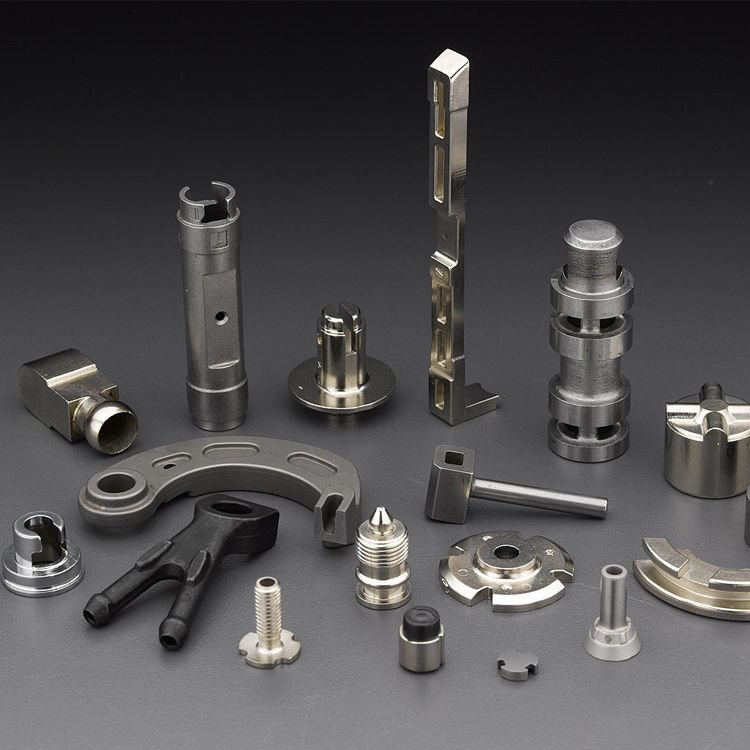CNC metal parts:
CNC (Computer Numerical Control) machining has become a core technology in metal part manufacturing due to its high precision, efficiency, and material adaptability. From aerospace to consumer electronics, various metal materials can meet diverse performance requirements through CNC processing. Below are common metal workpieces and their applications:

1. Aluminum Alloy
Properties: Lightweight (density 2.7 g/cm³), corrosion-resistant, easy to machine. Heat treatment (e.g., T6) enhances strength, achieving tensile strength up to 310 MPa.
Typical Components:
Aerospace: Aircraft skins, brackets (over 30% weight reduction, improved fuel efficiency).
Consumer Electronics: Laptop casings, smartphone midframes (anodized for matte finishes).
Automotive: Engine blocks, wheel hubs (superior heat dissipation compared to cast iron, 50% weight reduction).
2. Stainless Steel
Characteristics: Chromium content ≥10.5%, exceptional corrosion resistance (e.g., 304/316L grades), high strength (tensile strength 520-1030 MPa).
Typical Applications:
Medical devices: Surgical instruments, implants (316L medical-grade stainless steel, compliant with ISO 5832-1 biocompatibility standards).
Food processing machinery: Brewing equipment, piping (304 grade resists chloride corrosion, FDA certified).
Architectural finishes: Curtain wall fittings, handrails (mirror-polished finish, surface roughness Ra ≤ 0.05μm).
3. Titanium Alloys
Characteristics: High strength (strength-to-density ratio twice that of steel), high-temperature resistance (stable below 600°C), excellent biocompatibility.
Typical Applications:
Aerospace: Engine blades, landing gear (TC4 titanium alloy, superior fatigue resistance compared to aluminum alloys).
Medical field: Artificial joints, dental implants (Ti6Al4V ELI grade, adjustable porosity promotes osseointegration).
High-end sports: Bicycle frames, golf club heads (40% improved shock absorption, 60% lighter than steel components).
4. Copper Alloys
Characteristics: Exceptional electrical conductivity (pure copper conductivity ≥98% IACS), superior thermal conductivity (brass thermal conductivity 108W/(m·K)), high wear resistance.
Typical Applications:
Power Electronics: Terminal blocks, heat sinks (C1100 pure copper, contact resistance ≤0.5mΩ).
Automotive Industry: Bearing bushings, gears (C95400 aluminum bronze, hardness up to 30 HRC, 3x extended wear life).
Decorative Applications: Watch components, sculptures (C26000 brass, premium surface finishes via wire-brushing or gold plating).
5. Magnesium Alloys
Characteristics: Lightest structural metal (density 1.74 g/cm³), high stiffness (elastic modulus 45 GPa), excellent vibration damping properties.
Typical Components:
3C Products: Laptop casings, camera frames (AZ91D magnesium alloy, superior electromagnetic shielding compared to aluminum alloys).
Automotive lightweighting: Dashboard brackets, seat frames (significant weight reduction—every 100kg reduction lowers fuel consumption by 0.3L/100km).
Sports equipment: Snowboards, bicycle hubs (25% improved impact absorption, reducing sports injury risk).
6. Tool Steel
Characteristics: High hardness (HRC 58-65), red hardness (hardness retention ≥50HRC at 600°C), strong wear resistance.
Typical Applications:
Mold Manufacturing: Injection molds, die-casting molds (H13 steel, thermal fatigue life exceeding 100,000 cycles).
Cutting Tools: Drills, milling cutters (M42 high-speed steel, containing 8% cobalt, cutting speed 50% higher than standard steel).
Measuring Tools: Calipers, micrometers (GCr15 bearing steel, dimensional stability ≤1μm/year).
Conclusion
CNC machining achieves comprehensive material coverage—from lightweight aluminum alloys to high-temperature titanium alloys, and from highly conductive copper alloys to ultra-hard tool steels—through precise control of tool paths and cutting parameters.
Whether in the aerospace sector pursuing ultimate performance or the consumer electronics industry prioritizing cost-effectiveness, CNC-machined metal parts meet stringent manufacturing demands through material selection and process optimization.
